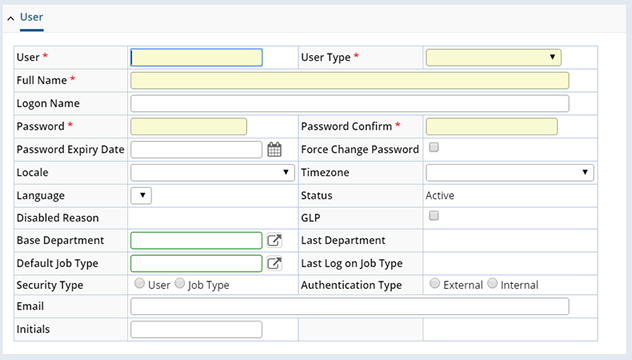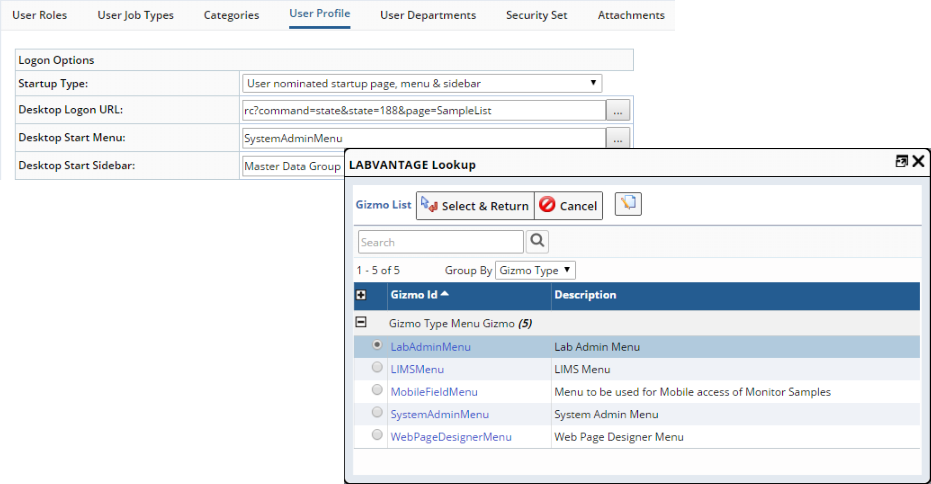Users
| Top |
|
Users and Roles |
Content |
||||||||||||||||||
|
Users |
|
|
User List |
 |
| Button | Description | |
| Add, Edit, View | Opens the User Maintenance page. | |
| List Control | ||
| View | Opens the User Maintenance page. | |
| Delete | Deletes the selected User from the SysUser table in the LabVantage database. | |
| Copy | Standard Copy button. | |
| SDC Access | Used to control SDC access with Departmental Security. See Departmental Security and SDC Access and Job Types in Concepts of LabVantage Security. | |
| Manage Modules | Launches the Module Users page, where you can assign the selected User to Modules. | |
| Security | ||
| Disable | Prompts you to enter a (free text) reason for disabling the selected User. If you satisfy this prompt by entering text for the reason, LabVantage disables the User. Disabled Users can not log onto LabVantage. | |
| Enable | Enables a User that is currently disabled. This prompts you before actually enabling the User. | |
| Force Password Change | Expires the selected User's current password. The next time the User logs on, he will be prompted to change his password. This is probably most useful when you change the properties of the Password Validator (see Password Validation) and want all Users to change their password to conform to the new rules. For example, all Users could be selected prior to clicking Force Change Password. | |
| Manage Departments
Manage Roles Manage Job Types |
There is a many-to-many relationship
between the Users and Departments (or Roles or Job Types). Accordingly,
this opens a ManyToManyMaint
page that lets you maintain this relationship. Selected Users on the
left can be assigned to or removed from the Departments, Roles, or Job Types
on the right. The example below shows Departments. These are "permanent"
Department assignments, meaning they are assigned to this Department by
the Administrator unless explicitly removed by the Administrator.
|
|
| Configuration Report | Launches the Configuration Report utility. | |
| Manage Calendar | See Calendars. | |
| Manage Core Hours | See Calendars. | |
| Privacy | ||
| Personal Info Report | Shows the Personal Information Data Report (see Data Privacy). | |
| Anonymize | Anonymizes the User's personal information (see Data Privacy). |
User Maintenance Page |

|
| Field | Description | ||||||||||||||
| User | Unique identifier for the LabVantage User (SysUser.SysUserId). This value cannot be altered after it has been saved. | ||||||||||||||
| User Type |
Based on the access rights you want to grant, choose the User Type. See User Principles in Concepts of LabVantage Security. Some of the User Types on the list are a combination of user access and license type.
Example: A Full Concurrent user can establish a connection to LabVantage as long as the number of currently connected users is below your license count for concurrent access. |
||||||||||||||
| Full Name | Name of the User that will appear on the User List page and potentially in audit logs. This value allows you to make changes as needed. | ||||||||||||||
| Logon Name | This can be used as an alternate to the "User"
name (SysUser.SysUserId). Users can logon and ESig using either the "User"
or optional "Logon Name" in combination with the User's Password.
If a "Logon Name" exists, it will be the security principal submitted to an External Authentication system. This provides the flexibility to map an externally-authenticated User to an existing LabVantage User. If specified, the Logon Name must be unique among all "User" names and "Logon Names", otherwise an error is generated. The "User" name and "Logon Name" are case-insensitive when a User logs on. In LabVantage 8.4.3 and higher, an error is generated if you create a "Logon Name" that is already in use, but differs only in case (such as "mary" and "Mary"). |
||||||||||||||
| Password
Password Confirm |
Enter a password for the User, then confirm the password
by reentering it.
The settings of the Password Validator control password syntax rules (see Password Validation). You can configure all User and Custodian passwords to be case-insensitive or case-sensitive. To configure this, use the System Configuration Security Option "Case Sensitive Passwords". |
||||||||||||||
| Password Expiry Date | Choose a date on which the User's password will expire. See Password Validation for controllable aspects of expiration. | ||||||||||||||
| Force Change Password | Expires the User's current password. The next time the User logs on, he will be prompted to change his password. | ||||||||||||||
| Locale
Time Zone |
User's Locale information. For current information concerning Locale, see Locale and Time Zone in the topic Internationalization and Localization. | ||||||||||||||
| Language | User's Language. Languages are defined in the Translation Maintenance Page. | ||||||||||||||
| Status | Shows the operational capability of the User:
|
||||||||||||||
| Disabled Reason | If the User has been disabled, this shows the reason provided during ESig. | ||||||||||||||
| GLP | BioBanking GLP flag. | ||||||||||||||
| Base Department
Last Department Default Job Type Last Logon Job Type |
See Departmental Security and SDC Access and Job Types (particularly Default Departments and Job Type Departments) in Concepts of LabVantage Security. | ||||||||||||||
| Authentication Type | Determines authentication through LDAP. "External" is through an LDAP server. "Internal" uses LabVantage authentication. See External Authentication. | ||||||||||||||
| Security Type | See Departmental Security and SDC Access and Job Types in Concepts of LabVantage Security. | ||||||||||||||
| User's email address. | |||||||||||||||
| Initials | User's initials. The Profile Menu shows these initials by default. This can be up to 3 characters. If no initials are set, the system generates initials from the User's full name. | ||||||||||||||
| External App | If you have selected a User Type of External App User, you will be required to choose an application. Therefore, the process begins by first registering the application, then creating a user, then creating the Authentication token. |
Roles |
|
|
Adding and Editing Roles |
Add and edit Roles from the Role List page. Note that you can also use the "Manage Roles" button on the User List page.
 |
| Button | Description | |
| Add, Edit, View | Opens the Role
Maintenance page:
|
|
| Delete | Deletes the selected Role from the LabVantage database. | |
| Copy | Standard Copy button. |
Assigning Roles to Users |
How you assign Roles depends on the Security Type:
|
Security Type = "User"
Security Type = "Job Type"
|
See Concepts of LabVantage Security for examples of how this works.
User Profile |
|
|
Overview |
The User Profile detail offers user-specific settings for Logon Options, Business Objects Options, Animation Options, and Notification Options. The "Logon Options" allows a System Administrator to set the User's startup page, Menu, and Sidebar for multiple devices:
|
|
The "Logon Options" settings override global settings in the GUI Policy. The order for obtaining the URL is:
| 1. | User Profile setting (above). | |
| 2. | "GUI Modes" property in the GUI Policy. | |
| 3. | "Default URL" property in the GUI Policy. |
The "Menu" and "Sidebar" options have the same precedence, but are preceded by first looking in the request (menu and group can be passed in), then the session (information is cached in the session until changed).
Startup Page |
The System Administrator has three options for specifying the User's startup page, as determined by the "Startup Type":
| Option | Startup Type | Description |
| Fixed | Assign a startup page, menu & sidebar | The System Administrator configures the "Logon URL" explicitly in the User Profile tab. |
| User | User nominated startup page | The User chooses his own startup page. |
| Last | Continue where user left off | The startup page is the last page accessed by the User before a logout. |
Settings can be defined for "Desktop" (PC), "Tablet", or "Phone" devices. Although the examples below use "Desktop" settings to set "Logon URL", the basic functionality is similar for "Tablet" and "Phone" devices, as well as "Start Menu" and "Start Sidebar".
| Fixed |
The System Administrator sets "Startup Type" to "Assign a startup page, menu & sidebar" and "Logon URL" to the User's startup page:
 |
When the User logs on, the specified page loads (in this example, the Sample List page). When he clicks "Change Preferences" in the upper right of the Layout, he sees only the Logon URL (read-only).
|
|
| User |
The System Administrator sets "Startup Type" to "User nominated startup page, menu & sidebar" and "Logon URL" to the User's startup page:
 |
When the User logs on, the specified page loads (in this example, the Sample List page). When he clicks "Set as Start Page" in the upper right of the Layout, the current page (last page logged into the page history) is set as the "Logon URL". For example, if the User is on the Sample List page and clicks "Set as Start Page", a message shows that the current page is set, and the User clicks "Close":
|
|
When the User clicks "Change Preferences" in the upper right of the Layout, the Edit User page loads. Clicking "Choose Current" makes the current page the User's startup page:
|
|
The User can also change the "Startup Type" to "Continue where I left off" (see "Last" below).
| Last |
The System Administrator sets "Startup Type" to "Continue where user left off":
 |
When the User logs out, the last page in the page history is saved as the "Logon URL". On next logon, the history is retrieved to load the last page.
The User can also click "Change Preferences" in the upper right of the Layout, and can choose to nominate a startup page.
|
|
Startup Menu and Sidebar |
System Administrators can set a User's "Start Menu" and "Start Sidebar" using options similar to the Startup Page options. Clicking the ellipsis lets you choose the Gizmo that renders the desired Menu or Sidebar. Note that these options are available for all devices. Only the Desktop opions are shown below for clarity.
 |
Default Workbook |
"Default Workbook" allows selection of the User's default ELN/LES Workbook.
| |
User Job Types |
|
|
See Concepts of LabVantage Security for examples of setting up Job Types..
User Departments |
|
|
This detail is populated based on the Department's Users (Departments → Department Maintenance Page → Department Users). The Department defines a User's Default Testing Lab and Shift (below left), both of which can be overridden for the User (below right).
 |
Calendars |
|
|
The "Calendars" detail defines and manages Calendars can be managed at the User level. This interacts with other levels of Calendar functionality. See Calendars → Calendar Management.
 |